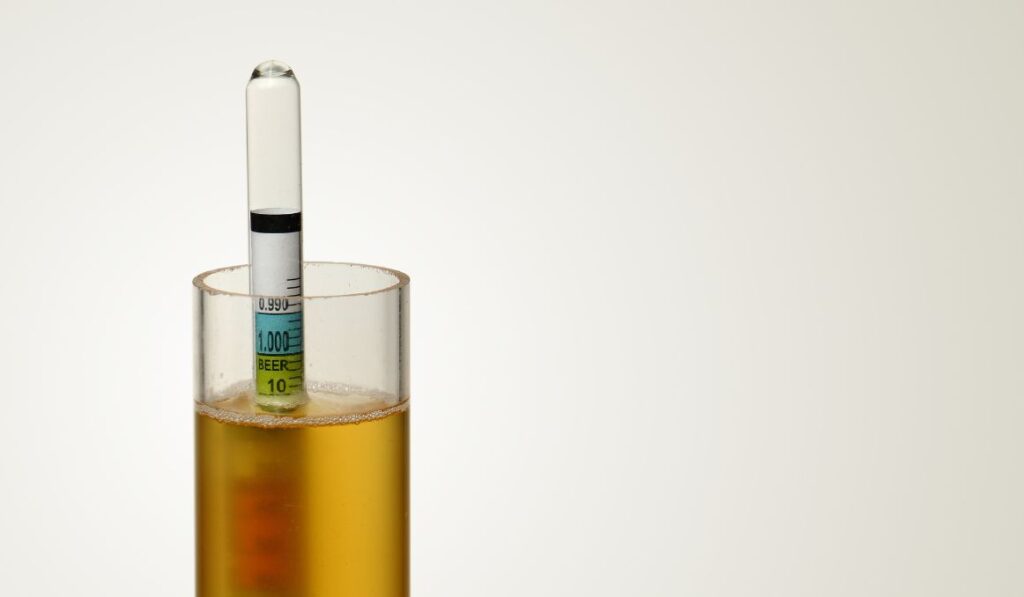How to check your homebrew’s gravity

What is Specific Gravity (SG)?
Specific gravity is the measurement of your beer’s density as compared to water. Sugar increases density, so by measuring the gravity of your beer, you can know how much sugar it contains. In order to determine how much sugar is left in the beer, home brewers will take an Original Gravity (OG) reading and then a Final Gravity (FG) reading. Using these two numbers, we can determine the total Alcohol By Volume (ABV) of the beer.
Using a hydrometer
The steps to use a hydrometer are as follows:
Obtain a hydrometer and sanitize it in your favorite sanitizer solution. Starsan is the preferred method in the United States. Spritz or submerge the hydrometer, hydrometer tube, and your preferred collection tool. A collection tool can range from a turkey baster, to a wine thief, to even collecting directly from the spigot on your fermenter.
Collect a sample. You want enough to fill the hydrometer tube at least 3/4 the way full or full enough so that hydrometer can float in the tube.
Place the hydrometer tube on a flat, level, surface. The hydrometer should be suspended in the beer inside of the tube. Spin the hydrometer to clear any bubbles that may have formed and to make sure that the hydrometer is not sticking to the side of the hydrometer tube.
Now, from eye-level, read the hydrometer’s measurement from the bottom of the meniscus. The meniscus is the curved surface caused by surface tension.
If done correctly, you should get a reading such as “1.055”. Most homebrewing hydrometers read in increments of “2”. So if you start at “1.040” then the next notch is “1.042”, followed by “1.044”, and so on until “1.050”.
Don’t forget to plug your results into a hydrometer calculator. You will need to consult your hydrometer’s paperwork to see what temperature the hydrometer is calibrated for. Generally speaking, hydrometers are calibrated to be accurate at 68F. https://www.brewersfriend.com/hydrometer-temp/
Using a refractometer for pre-yeast pitched readings.
The steps to use a refractometer are as follows:
A refractometer only needs a few drops of liquid in order to read gravity. Before your first use, you should calibrate your hydrometer per the instructions provided by the manufacturer. Generally this is done by using a few drops of distilled water and calibrating for “0”.
Sanitize any equipment being used to grab a sample of the wort. You can use a turkey baster, a spoon, or even an eye dropper.
Flip the plastic lid back that is on the front of the refractometer.
Place a few drops on the glass on the front of the hydrometer and gentle close the plastic lid on top of the sample.
Wait at least 30 seconds before looking through the eye hole. Consult the manufacturers directions to see how long you should wait for temperature correction.
Point the end of the refractometer toward a light source (sun, light bulb, etc) and peer through the eye hole. You will see Brix% on the left and SG wort on the right. Refer to the glossary above for terms and definitions.
Adjust the focus by turning the black knob near where your eye rests. Once in focus, read the SG starting at the bottom of the blue line. Take note of the brix as well as most calculators require you have the brix for proper calculation.
Write down your Original Gravity in both Brix and SG.
Using a refractometer for post-yeast pitched readings.
Refractometers can not accurately read the gravity when alcohol is present in the solution. Following the above steps up until step 7. Write down the Brix number associated with the reading and then head over to a refractometer calculator.
Input your OG or original Brix into the calculator. Next, input your current Brix into the second line of the calculator. The calculator will adjust based on the presence of alcohol giving you your current gravity reading.
A common SG reading when alcohol is present is 1.020 SG or 5 brix.
Refractometer Calculator: https://www.northernbrewer.com/pages/refractometer-calculator
Credit
www.reddit.com/r/homebrewing/wiki/faq/how-do-i-check-gravity/
https://www.oculyze.net/how-to-calculate-final-gravity-of-beer/